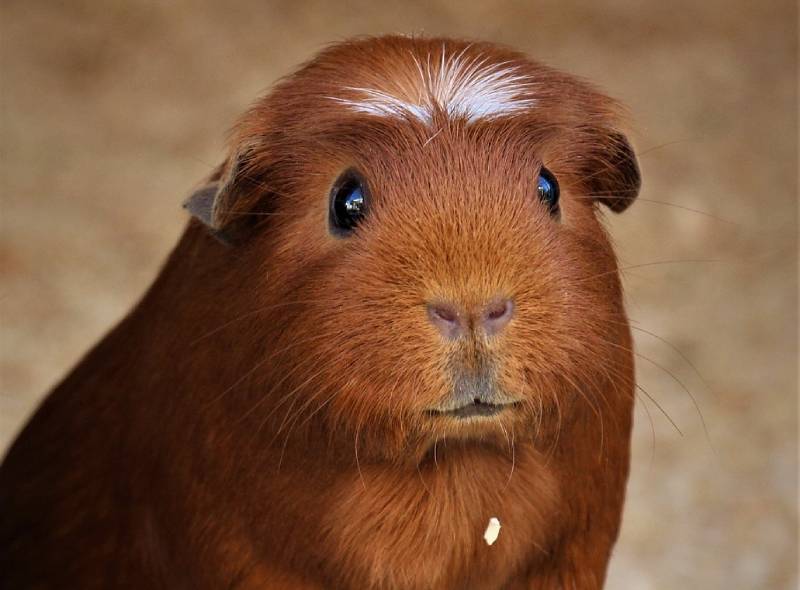Skinny Guinea Pig: Pictures, Lifespan, Behavior & Care Guide

Updated on

Click to Skip Ahead
The name “Skinny Guinea Pig” might make you think of a guinea pig on a diet, but it’s actually the name of a hairless breed of guinea pig first developed in the 1970s. While they were developed in a laboratory, the Skinny Guinea Pig is a popular pet today due to their tiny tufts of fur and smooth skin.
Here’s an introduction to the history of Skinny Guinea Pigs, along with details about their care needs, temperament, and other interesting facts, so you can decide whether the breed is right for you.
Breed Overview
| Size: | 12 inches long |
| Weight: | 1–2 pounds |
| Lifespan: | 7–8 years |
| Similar Breeds: | Baldwin Guinea Pig |
| Suitable for: | Apartments, families with older children |
| Temperament: | Docile, social, affectionate |
Guinea pigs are popular small pets, but many people think of them as fluffy goofballs. However, there are also hairless varieties, like the Skinny Guinea Pig, which was first developed in a laboratory and used as a test subject.
This purebred guinea pig variation is a result of the recessive hairless gene. When they were introduced to the pet market, they rapidly increased in popularity due to their unique appearance and their social and affectionate temperament.
Skinny Guinea Pig Breed Characteristics
How Much Do Skinny Guinea Pigs Cost?
The cost of the Skinny Guinea Pig is one area where they differ from other guinea pig breeds. While most cavies are quite affordable, Skinny Guinea Pigs are generally expensive due to the popularity of their unique appearance.
Skinny Guinea Pigs were introduced in a laboratory, so they haven’t always been kept as pets. They were first developed after scientists accidentally stumbled across the recessive hairless gene while breeding guinea pigs to experiment on. Although Skinny Guinea Pigs have only been kept as pets since the 1990s, they quickly rose in popularity and are often easy to find.
That said, on average, they cost between $100 and $200. They might cost even more if you’re looking for a particular color or if they’re descended from a champion breed line. This initial cost doesn’t include their enclosure, maintenance, ongoing supplies, or their veterinary care either. Their care needs mean they’re often surrendered to shelters, though, and adoption fees are often cheaper than if you visit a breeder.
Temperament & Intelligence of the Skinny Guinea Pig
If you’re looking for a small but sociable pet, and have experience with guinea pigs already, the Skinny Guinea Pig is a good option to consider. While they are slightly more difficult to care for than other guinea pig breeds due to their lack of hair, they are just as social and affectionate.
They need to be placed with a family that has plenty of time to dedicate to filling their social needs. It’s also recommended that you keep more than one Skinny Guinea Pig or pair them with another guinea pig breed so they always have a friend to socialize with.
Skinny Guinea Pigs are friendly and fond of cuddles, especially when they’re used to being handled from a young age, so make sure you give them plenty of attention and time out of their enclosure. They’re also intelligent, and with dedication and treats from you, they can be taught basic tricks, such as responding to their name and using a litter tray.

Do Skinny Guinea Pigs Make Good Pets?
In the right family, Skinny Guinea Pigs are good pets, but they do require a bit more care and attention than many other guinea pig breeds. While they’re social and love to be around people, their lack of hair does make them prone to injury and skin issues. You also need to take great care to ensure that their enclosure is out of the sun and kept at a steady, warm temperature so they don’t suffer from sunburn or get too cold.
Due to their size, they’re not recommended for young children, and you should supervise your children with any small pet. Younger kids can get overexcited and accidentally injure or frighten your Skinny Guinea Pig. Children need to be taught to be calm and gentle around small pets.
Do Skinny Guinea Pigs Get Along With Other Pets?
Friendly and social they might be, but Skinny Guinea Pigs don’t always get along with every other pet. They are best suited to a group of guinea pigs, whether the others have hair or not. Skinny Guinea Pigs can get along with some cats and dogs if you take the right precautions.
The biggest issue with cats and dogs is their hunter’s instincts. Since the Skinny Guinea Pig is a prey animal, both cats and dogs might see your guinea pig as something to hunt rather than a member of the family. Even if they’re friendly toward your guinea pig, you need to supervise their interactions. Never let them interact if your guinea pig is frightened by the presence of the other pet.
Things to Know When Owning a Skinny Guinea Pig
Besides their obvious lack of hair, the Skinny Guinea Pig isn’t that different from other breeds. They need extra food, care, and space, but most of their needs, such as their habitat and their veterinary visits, are the same as other guinea pigs. Skinny Guinea Pigs are also generally healthy despite their relatively short lifespan.
This section covers the Skinny Guinea Pig’s care needs and other requirements so you know how to take care of your new pet.

Food & Diet Requirements
The Skinny Guinea Pig eats the same food as other guinea pig breeds, though they do tend to have a bigger appetite due to their higher metabolism. Most of their diet should be focused on hay and grass. The hay should be high quality and always accessible. This will help encourage your guinea pig to gnaw on it throughout the day to keep their digestive system working and dental care tended to by naturally wearing down their teeth.
You can also supplement their diet with small amounts of vegetables, fresh fruit, and other vitamins and minerals. Vitamin C is especially important due to a guinea pig’s inability to create it themselves. To make sure they get all the nutrition that they need from their food, pellets formulated for guinea pigs are safe options.
Habitat & Enclosure Requirements
Like other small pets, Skinny Guinea Pigs need a sturdy and secure enclosure to call home. Make sure that the door shuts properly and that the enclosure has a roof or a lid if you have other pets that might harass your Skinny Guinea Pig. You also need to make sure the base is a solid tray rather than a simple wire floor, as the wire can hurt your Skinny Guinea Pig’s sensitive feet.
Since this breed usually eats more than other guinea pigs, make sure there’s enough space for them to run around in their enclosure to get exercise. This is even more important if you have more than one Skinny Guinea Pig. They all need enough space to live, explore, hide, and play together comfortably.
Exercise & Sleeping Needs
Skinny guinea pigs have an odd sleeping pattern. Where other animals will sleep through the day or the night in one sitting, guinea pigs will nap on and off throughout the day. They’re crepuscular, so most of their activity occurs in the early hours of the morning or evening, but their odd sleeping habits mean they’re also active at intervals through the day and night. Overall, guinea pigs will spend a total of 4–6 hours a day napping, but they still need a hideaway in their enclosure so they feel secure.
For their exercise needs, the Skinny Guinea Pig needs a slightly larger enclosure than most other guinea pig breeds. Their higher metabolism means they have more energy and need the extra space to run around. They also benefit from regular times out of their enclosure in a safe room where they can explore and spend time cuddling on your lap.
Training
If you’re a first-time guinea pig owner, you might not realize how intelligent these small animals are. Your new Skinny Guinea Pig might not be able to learn every trick in the book, but they can be trained with treats, dedication, and plenty of patience. Prepare yourself with their favorite treats, and teach them simple things like trundling up to you when their name is called or using a litter tray in the corner of their enclosure.
Remember to take it slow, and don’t get frustrated when they make mistakes. If your Skinny Guinea Pig starts struggling, take a few steps back or take a break and try again later.

Grooming
The Skinny Guinea Pig doesn’t have fur so you don’t need to brush them, but it’s still wise to check their skin for sore spots, lumps, pests, or skin problems regularly. Unless your Skinny Guinea Pig gets quite dirty, you won’t need to bathe them often. Their normal grooming habits are more than enough to keep them clean, but they might need a quick wash on rare occasions.
You’ll also need to keep their claws trimmed, clean their ears, and check their teeth at least once a week to make sure there aren’t problems. A diet rich in hay can help with their teeth maintenance, but regularly check their teeth, anyway. You should see a veterinarian if your guinea pig’s teeth are causing them problems.
Lifespan and Health Conditions
On average, Skinny Guinea Pigs live between 7 and 8 years. To help your guinea pig live as long as possible, you need to ensure that they have a balanced diet filled with the right nutrients, a safe enclosure, proper enrichment and social activities, and regular veterinary care.
Your Skinny Guinea Pig can be prone to a few health issues that frequently affect guinea pigs. They’re also more susceptible to skin problems due to having no protection from a furry coat. There haven’t been many studies on the breed yet to determine whether they’re more or less likely to suffer from certain ailments, but they’re generally considered to be just as healthy as hairy guinea pig breeds.
If your guinea pig isn’t eating, is quieter than usual, or is hiding more often, they might be stressed or ill. Take them to your veterinarian just in case.
- Skin conditions
- Eye problems
- Dental issues
- Cancer
Male vs. Female
Whenever you consider getting a new pet, the choice between male and female is always an important one to consider. The number of Skinny Guinea Pigs that you plan to keep also plays a huge part in this decision. Both sexes have different social needs and prefer different-sized social groups.
For large herds, it’s recommended that you choose female guinea pigs. They’re generally much more comfortable in groups larger than two or three. While they’ll have differences of opinion now and then, female Skinny Guinea Pigs are generally easygoing and happy to mingle with each other. You can also keep a single, neutered male with a larger group of females.
If you only have space for two or three guinea pigs, you can keep males together, especially if they’re from the same litter or are raised together. There’s a common misconception that male guinea pigs are more aggressive than females, but they’re just as social and friendly, provided that they’re taken care of properly. In the right enclosure and with the right company, male Skinny Guinea Pigs can thrive and be just as docile as females.
3 Little-Known Facts About Skinny Guinea Pigs
1. They’re Descended From Lab Animals
While most breed variations are a deliberate development, Skinny Guinea Pigs have a bit of a sadder story. The Skinny Guinea Pig is descended from guinea pigs that were used in lab experiments at a research facility in Montreal during the 1970s. Hairlessness in guinea pigs is a recessive trait and is only possible if both parents carry the hairless gene, so the first Skinny Guinea Pigs were an accident.
However, once the hairless gene was identified, the lab started using Skinny Guinea Pigs as test subjects for dermatological products. It wasn’t until the 1990s that hairless guinea pigs found their way to the pet market. Since then, their hairlessness has made them unique and highly desired pets among guinea pig lovers.
2. Some Skinny Guinea Pigs Have Hair
Skinny Guinea Pigs might not be the fluffy pet that you imagine when you first think of guinea pigs, but many of them do have tufts of fur. The Skinny Guinea Pig can grow fur on their nose and their feet. Some of them even have fur along their back and on their rear. The rest of their body is always hairless, however.

3. When They’re Bred With Baldwin Guinea Pigs, the Young Have Hair
Since the Baldwin Guinea Pig is also a hairless breed, it’s easy to assume that breeding them with the Skinny Guinea Pig will result in a hairless crossbreed. However, the hairlessness in the Baldwin and the Skinny Guinea Pigs is caused by two different genes. If you breed the two together, the young will have hair, since the recessive hairless genes won’t match and the dominant genes will take over.
Conclusion
When anyone thinks of guinea pigs, they inevitably think of hairy goofballs trundling around an enclosure. While hairless varieties aren’t found in the wild as a natural occurrence, the Skinny Guinea Pig is just as popular as the hairy breeds that most people are familiar with.
As a descendant of laboratory guinea pigs and first used as subjects for dermatological product tests, the Skinny Guinea Pig didn’t have the best start to life. However, they were quickly introduced to the pet market due to their unique appearance and have since shot up in popularity.
Despite their recessive hairless genes, they’re purebred guinea pigs, so they share the same friendliness, sociability, and affectionate natures as other guinea pig breeds. However, their hairless skin does mean they have a few extra care needs, such as protection from the sun and the cold.
The Skinny Guinea Pig might not be as easy to care for as other breeds, but they still love to cuddle, and what they lack in fur, they make up for in friendliness. They need a family who can meet their social needs, afford to take care of two or three guinea pigs, and provide plenty of cuddles.
Featured Image Credit: I.K.Media, Shutterstock











